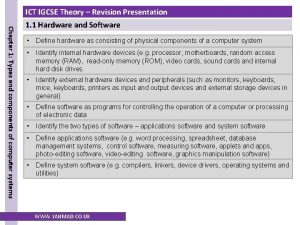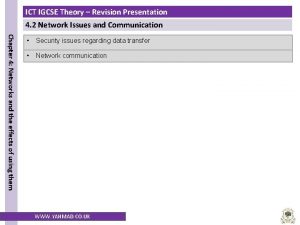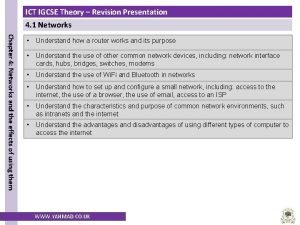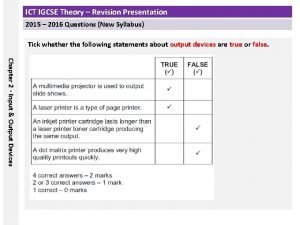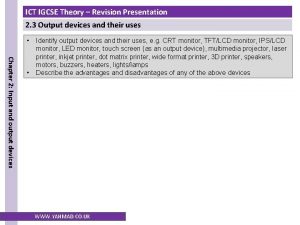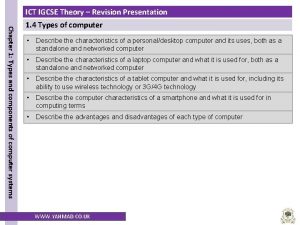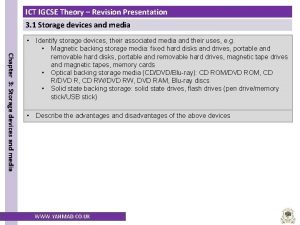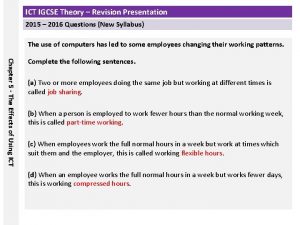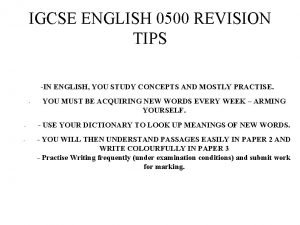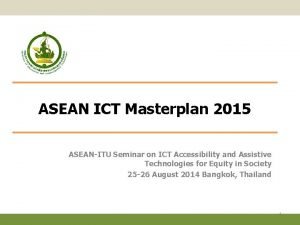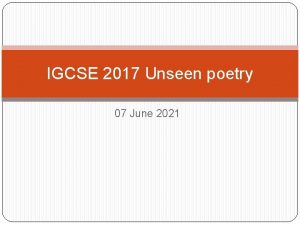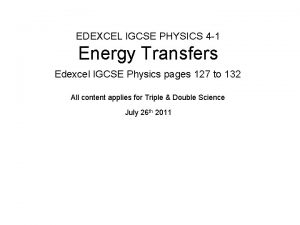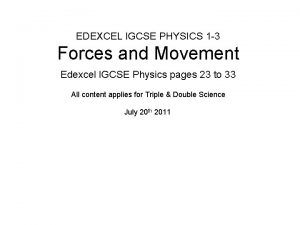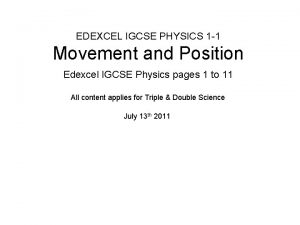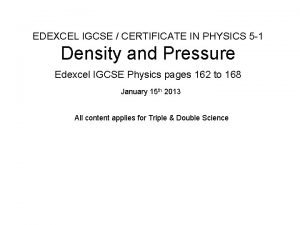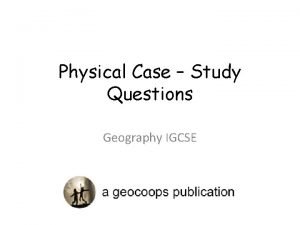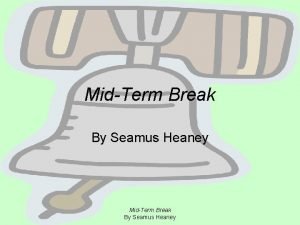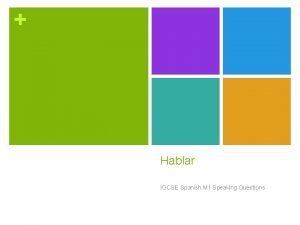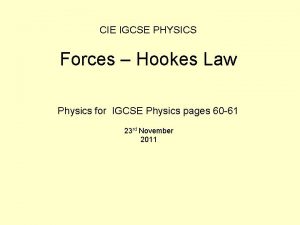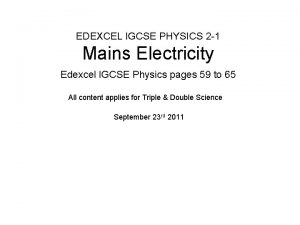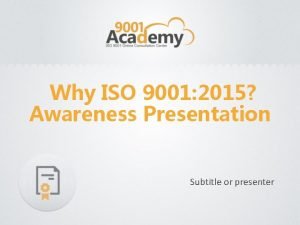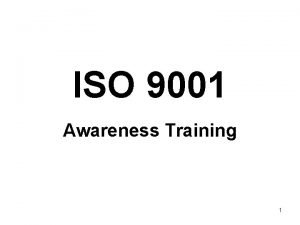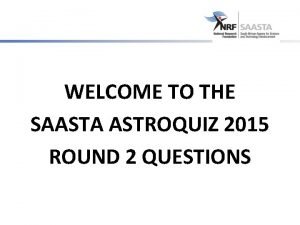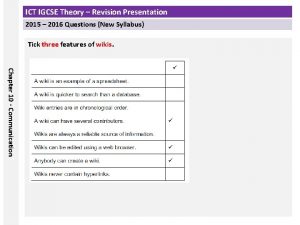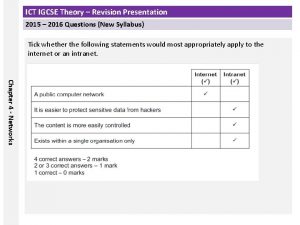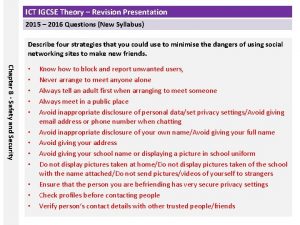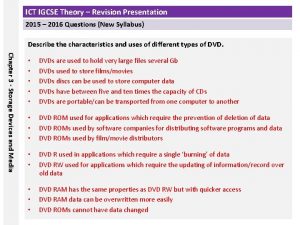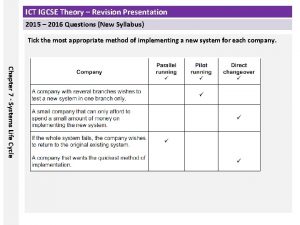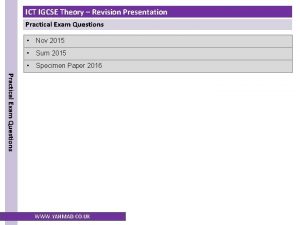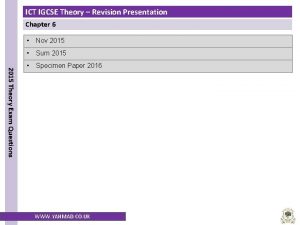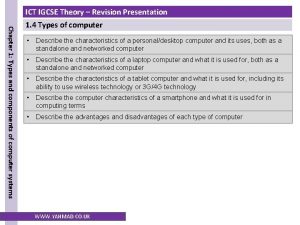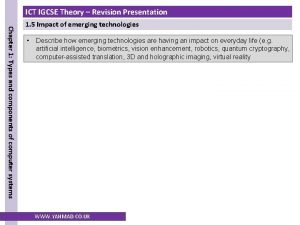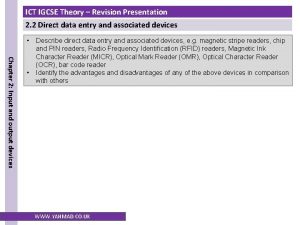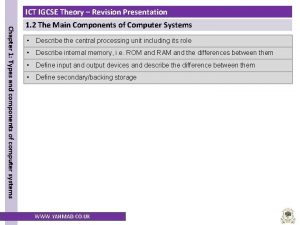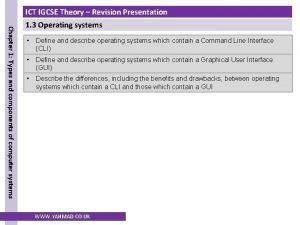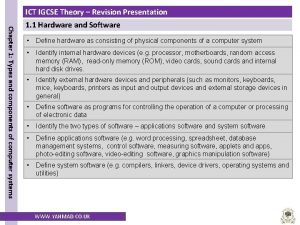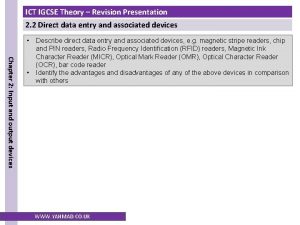ICT IGCSE Theory Revision Presentation 2015 2016 Questions
























- Slides: 24

ICT IGCSE Theory – Revision Presentation 2015 – 2016 Questions (New Syllabus) The following diagram shows towns A and B and the two roads that connect them. Chapter 6 - ICT Applications Describe how a satellite navigation system (sat nav) in a motor vehicle would calculate the quickest route from A to B. • • Destination B is input by driver Position of motor vehicle at A is calculated using GPS …using data transmitted from 3/4 satellites Algorithm calculates shortest distance from A to B (going through C) Algorithm calculates distance from A to B not going through C Makes allowances for traffic in town C and takes into account average road speeds… using traffic/speed sensors on roads Takes into account regular updates of traffic conditions Takes into account max. speed on the road/type of road

ICT IGCSE Theory – Revision Presentation 2015 – 2016 Questions (New Syllabus) In certain countries, the RFID chip in a passport is scanned when the passport is presented at an automated passport control gate. Chapter 6 - ICT Applications Give three items of information about the passport holder that are stored on the RFID chip. • Name • Passport number • Date of birth • Place of birth • Nationality • Issue date • Expiry date • Facial characteristics/photograph/fingerprint/retina scan • Biometric measurements (face) • Signature • Gender • Place of issue

ICT IGCSE Theory – Revision Presentation 2015 – 2016 Questions (New Syllabus) Chapter 6 - ICT Applications Describe how RFID technology reads the details from the chip. • The chip is presented near a computer with a radio-frequency scanner • The scanning antenna puts out radio-frequency signals in a relatively short range. • It provides a means of communicating with the transponder/the RFID tag • The scanning device provides energy… • …so that the chips can broadcast the information in them… • …for the computer to read. Explain why RFID technology is used for reading data from passports. • More secure than a traditional passport as biometric measurement data difficult to forge • Counterfeits can be more easily identified than non-RFID passports • More rapid flow at security check points/quicker than reading it manually

ICT IGCSE Theory – Revision Presentation 2015 – 2016 Questions (New Syllabus) Chapter 6 - ICT Applications “Chip and PIN is the new, more secure way to pay with credit or debit cards ”. Discuss the accuracy of this statement with regard to developments, since and including the use of magnetic stripe cards at EFTPOS terminals and ATMs. Examples of more secure: • Even when the card is stolen, the thief still needs the PIN, so it is much safer • Data more difficult to copy • Larger amount of information can be stored • Disabled people find it easier than signing • Reduces disputes at checkouts over validity of signature/Saves time at checkouts • Not affected by magnetic fields • If the transaction did not take place near a terminal (in a restaurant, for example) the card had to be taken away from the customer to the card machine. • Even at the terminal, the criminal could bend down in front of the customer and swipe the card on a hidden reader. • Illegal cloning of cards easy, and a common occurrence.

ICT IGCSE Theory – Revision Presentation 2015 – 2016 Questions (New Syllabus) Chapter 6 - ICT Applications “Chip and PIN is the new, more secure way to pay with credit or debit cards ”. Discuss the accuracy of this statement with regard to developments, since and including the use of magnetic stripe cards at EFTPOS terminals and ATMs. Examples of not always secure because: • Cards can still be cloned • People can be careless when using their PIN. • Credit and debit card fraud has gone down with chip and pin • ATM fraud has gone up. • Hidden cameras sometimes are used to see which keys are pressed for the PIN. • The advent of chip and pin has also generated a rise in phishing

ICT IGCSE Theory – Revision Presentation 2015 – 2016 Questions (New Syllabus) A school has introduced a system so that parents of its students can access data about their children. Chapter 6 - ICT Applications Give three reasons why the school has introduced this system. • • To save printing costs of reports To ensure test results, etc. are received by parents To allow immediate feedback to parents after tests/exams To keep parents up to date with child’s progress/targets

ICT IGCSE Theory – Revision Presentation 2015 – 2016 Questions (New Syllabus) Give three specific examples of work that are carried out by a robot in the car industry. Chapter 6 - ICT Applications • • Putting wheels on cars Painting car bodies Welding parts on a car body Carrying car windscreens/doors Moving goods in an automatic warehouse Placing engine block into body Installing transmission system

ICT IGCSE Theory – Revision Presentation 2015 – 2016 Questions (New Syllabus) Give three reasons why it would not be sensible to use batch processing in an online theatre booking system. Chapter 6 - ICT Applications • • It might lead to double booking Customer would not be sure booking has been successful Would take a long time to receive confirmation/ticket Processing would take a long time which would cost company money

ICT IGCSE Theory – Revision Presentation 2015 – 2016 Questions (New Syllabus) A chemistry student wants to measure how quickly a liquid cools after it has boiled. She will use a sensor connected to a computer to do this. Chapter 6 - ICT Applications Identify two variables which will need to be recorded. Temperature & Time Describe how the computer would process the data into a form the student could use to analyse the results. • The sensor feeds back data to computer • Data is converted from Analogue to Digital • Readings are stored in a spreadsheet/software package • Graphs are automatically produced by computer… • . . . plotted against time • Calculations performed on spreadsheet to show rate of cooling • Graphs examined to see general overview of rate of cooling

ICT IGCSE Theory – Revision Presentation 2015 – 2016 Questions (New Syllabus) Most supermarkets now operate online shopping. Discuss the advantages and disadvantages to supermarkets of this development. Chapter 6 - ICT Applications • • • Initial cost of hardware/software is expensive Fewer staff needed – less spent on wages Fewer shops needed – less spent on rates/rent/utilities Potentially larger customer base Need to retrain staff Less customer loyalty/loss of customers/more difficult to sell other services/products due to lack of personal touch Costs of system maintenance Greater costs due to more delivery staff/vans

ICT IGCSE Theory – Revision Presentation 2015 – 2016 Questions (New Syllabus) Describe three benefits to customers of using internet banking. Chapter 6 - ICT Applications • • • Save travelling expenses Saves time travelling/queuing Elderly/disabled people don't have to travel No embarrassment having to ask for loans face to face Can bank when banks are closed Use it anywhere there's an internet connection

ICT IGCSE Theory – Revision Presentation 2015 – 2016 Questions (New Syllabus) Financial models and scientific experiments are examples of different types of modelling applications. Chapter 6 - ICT Applications Give three other examples of types of modelling. • • • Simulations Mathematical models Civil engineering models Flight/pilot simulation/training Design of fairground rides Traffic control Building fire simulation Weather forecast models Population modelling

ICT IGCSE Theory – Revision Presentation 2015 – 2016 Questions (New Syllabus) A ferry connects two countries. When car drivers approach the ferry they have to check in to confirm the details they have already booked. If they drive in to the self check-in lane, details of the car are automatically input to a computer. Chapter 6 - ICT Applications The terminal which is used for the driver to identify themselves produces a personalised welcome message on a screen. There is a database which contains details of the driver and the car. Write down the data which is automatically input to the computer. The car registration number Other than your answer to (a) give two items of data stored in the computer database. • Car owner's name • Car driver's name • Height/ Length of vehicle • Colour of vehicle • Credit/debit card details • Make of car/model of car

ICT IGCSE Theory – Revision Presentation 2015 – 2016 Questions (New Syllabus) Chapter 6 - ICT Applications Explain how Optical Character Recognition is used before the computer processes the data. • As the car arrives a camera takes a snapshot of the number plate as an image • Stores it in a file • Software identifies where number plate is in image and crops that part of the image • The OCR software converts the registration number to numbers/letters Explain the computer processing which takes place to produce the personalised message. • The number plate is compared… • …with those stored on the customer file • When a matching record is found • The name of the customer is read • The name is merged into the message • And a signal is sent to screen to display the appropriate part of the message

ICT IGCSE Theory – Revision Presentation 2015 – 2016 Questions (New Syllabus) Chapter 6 - ICT Applications Explain what is meant by VOIP. • Voice over Internet Protocol • A set of rules that enable people to use the Internet to make telephone calls/talk each other • Sends voice data in packets using IP Name two items of computer hardware that are needed in order to make a VOIP phone call from one computer to another. • Microphone • Speakers/headphones • Headset

ICT IGCSE Theory – Revision Presentation 2015 – 2016 Questions (New Syllabus) A customer wishes to check the balance of their bank account and inserts their card into the ATM. Chapter 6 - ICT Applications Describe the computer processing which takes place at the ATM. • • • The bank account details are read from the chip The (ATM) checks to see if the card is valid The customer is asked which language/currency they require The customer is asked to type in their PIN The typed PIN number is compared with that stored in the chip… …if they are the same the transaction proceeds …if they are not the same the customer is asked to re-enter PIN If three failed attempts transaction rejected and card withheld The customer is asked which service is required Customer is asked if they want a printed balance/onscreen balance If yes, signal sent to print balance/message sent to screen giving balance The customer is asked if further services are required

ICT IGCSE Theory – Revision Presentation 2015 – 2016 Questions (New Syllabus) A customer wishes to check the balance of their bank account and inserts their card into the ATM. Chapter 6 - ICT Applications Describe the computer processing which takes place at the bank’s computer. • • Checks whether card is stolen/account number exists Customer account number is searched Balance field is read/is calculated Message sent to ATM giving balance

ICT IGCSE Theory – Revision Presentation 2015 – 2016 Questions (New Syllabus) When a bank cheque is presented to a bank it is sent off to a cheque clearing centre. Give three items of information that are pre-printed on the cheque in magnetic ink. Chapter 6 - ICT Applications • • • Account number Bank/branch sort code Cheque number Describe how MICR is used to read these details from the cheque. • • • Requires a special Magnetic Ink Character reader/scanner/Details are scanned The magnetic ink on the cheque passes over a magnet in the reader/scanner which charges/magnetises the ink The MICR reader/scanner then reads the magnetic signal given out by the magnetic ink characters on the cheque. Each character produces a unique signal which is read and translated by the MIC reader Explain why magnetic ink is used rather than bar codes on a cheque. • • • More difficult to forge Even if overwritten/damaged can still be read by computer Information is human readable

ICT IGCSE Theory – Revision Presentation 2015 – 2016 Questions (New Syllabus) Identify four uses of online booking systems. Chapter 6 - ICT Applications • • • Air flight tickets Theatre tickets Holiday booking Cinema tickets Rail tickets Hotel room booking Restaurant table/seat booking Football match booking Concert/performance booking

ICT IGCSE Theory – Revision Presentation 2015 – 2016 Questions (New Syllabus) A school library uses a computer system where there is a book file and a borrower file. Each student has a unique membership number and each book has a unique accession number. Chapter 6 - ICT Applications The accession number is the number given to a book when it is first bought by the library. When a book is borrowed, the student has their thumbprint read by a special input device. Describe the computer processing involved when a book is borrowed. • The books database is searched to find the accession number • The fingerprint scan is converted into digital data patterns • The computer then maps points on the fingerprints and uses those points… • …to search for similar patterns in the (borrower) database. • Matching record is found • The membership number is retrieved • Record is checked to see if number of books allowed is not exceeded/are fines due? • The membership number is written to the file against the accession number in the • books database The accession number is written against membership number in the borrower file.

ICT IGCSE Theory – Revision Presentation 2015 – 2016 Questions (New Syllabus) A school library uses a computer system where there is a book file and a borrower file. Each student has a unique membership number and each book has a unique accession number. Chapter 6 - ICT Applications The accession number is the number given to a book when it is first bought by the library. When a book is borrowed, the student has their thumbprint read by a special input device. Describe the computer processing involved when a book is returned. There is no need for the borrower to have their thumbprint read during this process. • • • Accession number is compared with those on book file Matching record is found Record is flagged as returned/changed to returned The accession number is deleted against membership number in the borrower file/borrower is recorded as having borrowed one less book Computer calculates if book has been returned overdue

ICT IGCSE Theory – Revision Presentation 2015 – 2016 Questions (New Syllabus) Chapter 6 - ICT Applications When customers use phone banking they are connected to an automated system. Give two items of data they are asked to key in to identify themselves to the system. • • • Sort code Account/bank card number 3 digits from password/passcode Memorable date/mother’s maiden name/favourite place/answer to security question/place born Date of birth Identify three services that they can use in phone banking. • Transfer money to a different account or between accounts • Pay bills or amend/create standing orders/direct debits • Order a new PIN • Stop a cheque • Can ask about recent/pending transactions • Can apply for a loan • Can check account balances • Can amend personal details

ICT IGCSE Theory – Revision Presentation 2015 – 2016 Questions (New Syllabus) A student exam answer sheet consists of boxes or lozenges which the student shades in to indicate their choice of answer. Chapter 6 - ICT Applications Apart from the details of the test and the lozenges, give two items of information, essential to the student, that are pre-printed on the answer sheet. • Student id number/prompts for student number • date of birth • student name • Instructions on how to complete the form • Question numbers • Centre number • Centre name Describe how Optical Mark Recognition is used to process the details from the form. • • Dedicated scanner device shines a beam of light onto the form Light is reflected back to sensors Marks reflect less light so sensors used to identify position of marks Computer compares these with correct answer positions

ICT IGCSE Theory – Revision Presentation 2015 – 2016 Questions (New Syllabus) A student exam answer sheet consists of boxes or lozenges which the student shades in to indicate their choice of answer. Chapter 6 - ICT Applications Describe the drawbacks of using Optical Mark Recognition • • • If the marks don't fill the space completely they may not be read correctly/overfill the space/smudged If the marks are not in a dark enough pencil they may not be read correctly If more than one lozenge shaded in result is invalidated Only suitable for recording one out of a selection of answers, not suitable for text input Have to use prepared forms which may be expensive Examinations could consist of mainly multiple-choice questions changing the nature of what is being tested
 Igcse ict theory revision
Igcse ict theory revision Ict igcse theory revision presentation
Ict igcse theory revision presentation Igcse ict chapter 4
Igcse ict chapter 4 Igcse ict chapter 2 questions
Igcse ict chapter 2 questions Ict igcse theory revision presentation
Ict igcse theory revision presentation Ict igcse practical revision presentation
Ict igcse practical revision presentation Igcse ict
Igcse ict Igcse ict chapter 5
Igcse ict chapter 5 Igcse
Igcse Active and passive vocabulary
Active and passive vocabulary Asean ict masterplan 2015
Asean ict masterplan 2015 Unseen poetry igcse
Unseen poetry igcse Sankey diagram physics
Sankey diagram physics Igcse physics forces and motion
Igcse physics forces and motion Edexcel igcse physics movement and position questions
Edexcel igcse physics movement and position questions Pressure force and area
Pressure force and area Igcse geography case study questions
Igcse geography case study questions Mid-term break analysis
Mid-term break analysis Igcse spanish speaking questions
Igcse spanish speaking questions Hookes law graph
Hookes law graph Mains electricity notes
Mains electricity notes Iso 9001:2015 awareness training ppt
Iso 9001:2015 awareness training ppt Iso 9001 presentation
Iso 9001 presentation Astro quiz round 2
Astro quiz round 2 Saasta astro quiz 2015 questions and answers
Saasta astro quiz 2015 questions and answers
